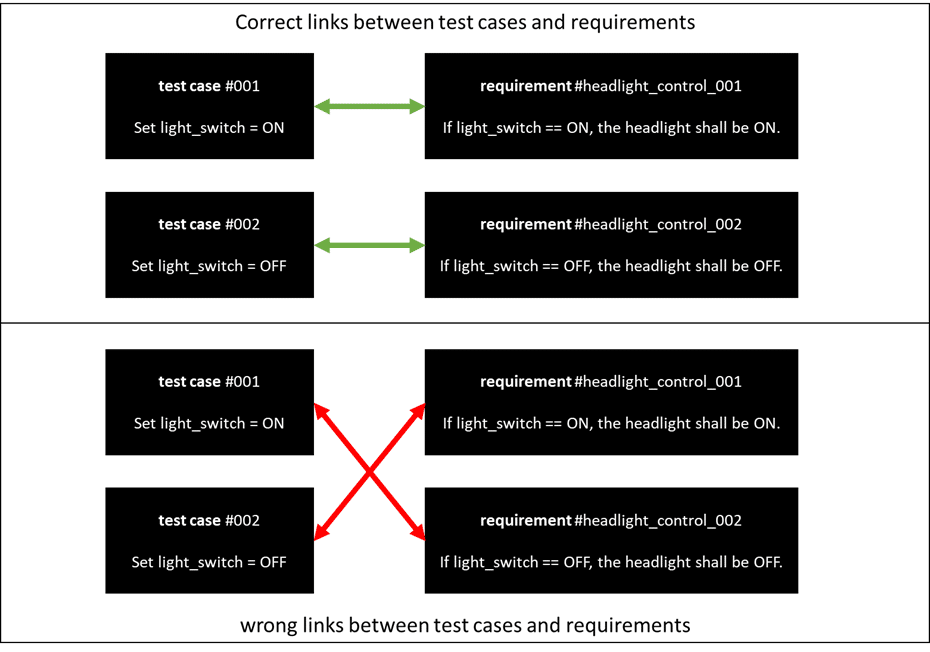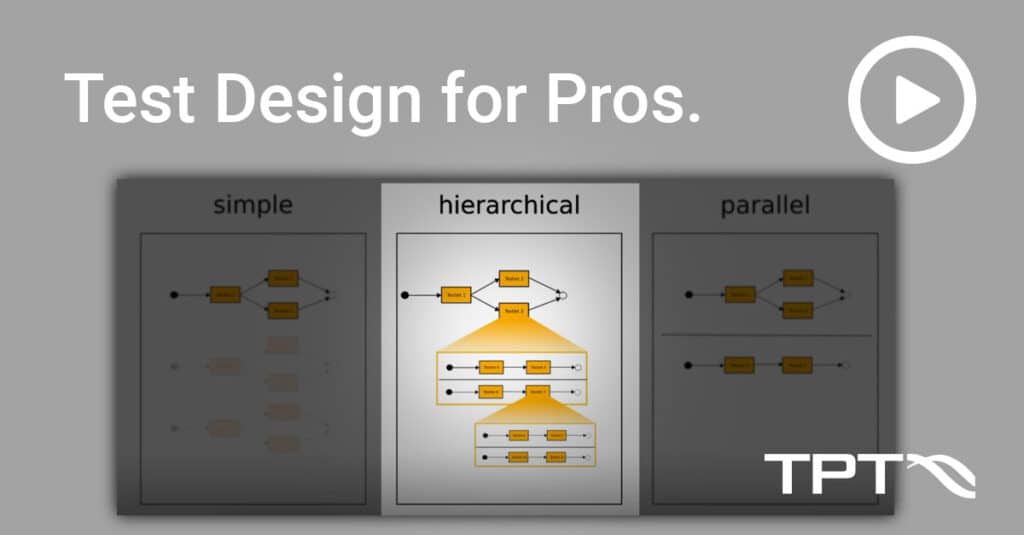
Method for ensuring the validity of tests.
Next to providing one of the best test tools in the embedded sector, we also test software products on behalf of customers from the automotive industry (including driver assistance functions, drive components, control software for charging and battery systems).
Over time, we have also experienced bugs in the testing process. To avoid process errors, we have developed various strategies and methods. Always with the aim – to be able to provide our customers with high-quality statements on their developments quickly.
In the following, we would like to explain one of these methods in detail. It was developed by our test engineers and is used daily in practice.
The purpose of this method is to ensure at all times that a test case actually tests a requirement linked to it.
Here’s a quick example of why this is so important.
In a software for controlling the exterior light of a vehicle, the exterior light should always be switched on when the light switch is in the ON position.
In the worst case, this requirement is only linked to test cases that never contained the condition light switch is in ON position . If these test cases successfully test another aspect (e.g. light switch is off and the exterior light remains off), the linked requirement could be considered as sufficiently tested.

Incorrect links can occur in different ways:
1. the tester creates a wrong link between test case and requirements
2. an existing link loses its significance over time due to a change in the test item
There is a simple and quickly implementable solution that solves this problem.
In our method, each test case is reported as failed if it does not test the linked requirement correctly. A failure due to an incorrect link is detailed in the report.
Our approach is essentially based on the possibility to define test data and expected values separately.
In TPT, the expected results of a test item – in this context we also speak of the test oracle – can be described with the help of Assesslets. Assesslets can be used for the evaluation of several test cases simultaneously.
The method is implemented in 5 steps:
1. Import of Requirements into TPT
2. Creation of 1 Assesslet per Requirement
3. Creation of a Check Script
4. Creation of Test Cases
5. Linking of Test Cases with Imported Requirements
Step 1: Import of Requirements into TPT
Import can be done in several ways. For this method, it is only relevant that the requirements are available in TPT.
Step 2: Creation of 1 Assesslet per Requirement
The purpose of an Assesslet is to specify the expected behavior of a test object under defined conditions. This single-source-of-truth definition can then be used for multiple test cases.
How to do this?
Create a new script Assesslet for each requirement in the Assesslet folder, name it accordingly and implement it.
The implementation of an Assesslet contains the following elements:
1.define conditions or case distinctions (usually derived from the requirements)
2. define the expected value of each condition (some are simple, some are complex)
3. add an annotation of which requirement is covered by which expected value
For our lights control example above, here is a reference implementation for an Assesslet that checks the requirement with the ID 2018 “If light switch is ON, then headlight shall immediately be ON”:

Assesslet to check requirement with ID 2018: Condition “While the light switch is in position 1 (line 3)”. Our expected value is documented in line 4: TPT.CheckAlways() checks whether the headlight == true. With REQUIREMENTS.checked(), an attribute attached to the requirement with the ID “2018” is overwritten with the result (from line 4).
The procedure is the same for other requests.
Step 3: Creation of a Check Script
Another Assesslet script is then used to check whether all requirements linked to a test case have a defined attribute. In the case of the Assesslet, this is done by line 5 with the function REQUIREMENTS.checked(). When this is called, the default value is changed.
In other words, for each test case, for each requirement linked to that test case, we check the attribute for the default value. If the default is present, there is either no test Assesslet or an incorrect test Assesslet for the requirement.
Here is a reference implementation:
def RetArgumentofResultAsString(argument):
if argument == -1: return "no result"
elif argument == 0: return "failed"
elif argument == 1: return "passed"
elif argument == 2: return "ionconclusive"
elif argument == 3: return "execution error"
else: return ""
Check_SignificanceLinkingRequirements = TPT.BooleanX();
checkreq = true; # used as indicator, if one test case has at least one unchecked linked requirement
wronglinkedrequirements = ""; # used for collecting not checked requirements
correctlinkedrequirements = ""; # used for collecting successfully checked requirements
Table = TPTReport.Table()
Table.setHeader("Req ID", "Testresult", "Requirements-Text")
for p in REQUIREMENTS.getRequirementsLinkedToCurrentTestCase():
Table.addRow(str(p.getId()), RetArgumentofResultAsString(REQUIREMENTS.getResult(p.getId())) , p.getText()).setResult(1)
if REQUIREMENTS.getResult(p.getId()) in [-1, 2] : #-1 not covered; 2 no result = inconclusive
checkreq = false #one-time set for every test case, if at least one requirement is linked but not checked
if wronglinkedrequirements == "": # true, if first time a linked requirement is not checked
wronglinkedrequirements = "ID: " + wronglinkedrequirements + p.getId()
else:
wronglinkedrequirements += "; " + p.getId()
else:
if correctlinkedrequirements == "": # true, if first time a linked requirement is not checked
correctlinkedrequirements = "ID: " + correctlinkedrequirements + p.getId()
else:
correctlinkedrequirements = correctlinkedrequirements + "; " + p.getId()
if correctlinkedrequirements == "": correctlinkedrequirements = "no linked requirements"
Check_SignificanceLinkingRequirements := TPT.check(checkreq == true, true,
"All linked Requirements (" + correctlinkedrequirements + ") are checked with this test case.",false,
"Requirements (" + wronglinkedrequirements + ") linked to this test case are not checked. Please check your Assesslet definitions."
+ (correctlinkedrequirements=="" ? "This test case do not cover any linked requirement.":
"This test case checks other linked requirements (" + correctlinkedrequirements + ")"));
TPTReport.add(Table) #adds the table in report for each test case
You need to move this script into the report section. Then it will run after the Assesslets to check the requirements.
Step 4: Creation of Test Cases
Follow the link to see how to create a test case here.
Step 5: Linking of Test Cases with Imported Requirements
The linking of requirements with tests or vice versa can be done by drag and drop. Select some test cases and drag them over the requirements. Done.
See more about Requirements and Tracing here.
What are the advantages?
The advantage of this procedure is that incorrect links in the reporting are immediately and easily visible. Each incorrectly linked test case is identified as a failed test case in the report.
The report thus gives the user a quick overview of whether relevant test cases have been created for all requirements. At the same time, this increases productivity, as analyses of the degree of completion can be omitted.
What must be considered in the application of this method?
Assesslets should be checked for correctness and consistency with requirements. Only if the Assesslets are correct do they have any significance. This is the actual engineering work in testing. We cannot (yet) take this off your hands.
Further hints and recommendations:
In some of our projects, we do not link the script Assesslets directly to requirements. However, a mapping is done by naming convention: in that each requirement-testing script Assesslet has the following structure “Ass_” & <Requirements-ID>. The requirements for bidirectional traceability (e.g. from Automotive SPICE) are thus fulfilled in principle, as a pairing can be determined at any time.
Summary
Our method for ensuring the significance of tests is compliant with the requirements of Automotive SPICE and ISO26262.
In its application, it requires basic functions of the test automation used, such as the separation of test data for stimulation and a separate definition of expected behavior for the test object.
We have been using this method successfully in safety-critical automotive projects for several years.
Our engineers are convinced by the intuitive procedure and no longer want to do without it, among other things because time-consuming manual checks of the correctness of links can be omitted.
The effort required to write scripts and check them for the correctness of Assesslets and requirements is manageable and significantly lower than alternative measures such as reviews & walkthroughs.
Related topics

Read more »

Read more »

Read more »

Watch now »

Watch now »

Watch now »
